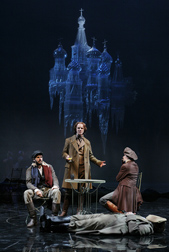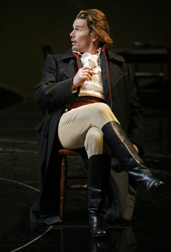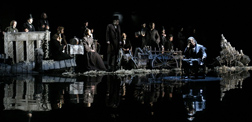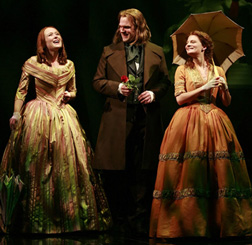Details of personal lives overwhelm epic of politics and action
By Lucy Komisar
Tom Stoppard‘s theater trilogy about Russian radicals and reformers of the 19th century is a drawing room drama of upper class life overlaid with the revolutionary ideas that set the stage for the Russian revolution. The content is disappointing, a Russian history “lite” that seems to want to make viewers feel as if they are getting to know the shapers of history without being forced to concentrate too seriously or for too long on their actions and ideas.
Characters are placed and moved through stylized vignettes as if in a diorama, in tableaux. The pageants are beautiful, but sometime they lack substance. Often there are pronouncements instead of dialogue. And, unfortunately, just announcing events rather than showing them makes even exciting history lifeless.

The best part of the production is the stunning staging by director Jack O‘Brien. “Salvage” opens with the cooing of pigeons and the lapping of waves made real by sound and light. There‘s little scenery: perhaps a dining table, the bed and table in someone‘s room, a villa‘s silvery chairs or, in summer, rattan, and a chandelier that seems to be an onion domed ice sculpture. All are set on a shiny round black marble stage. (The sets are by Bob Crowley and Scott Pask.) The clothes of the aristocracy lend fashionable elegance, especially at a Russian costume ball. (Costumes are by Catherine Zuber.)
The epic begins in 1833, on the estate of the family of Michael Bakunin, now known to the world as the originator of anarchism, and takes us through 35 years with the story of six friends, intellectual aristocrats, who sought to change the repressive Czarist regime. They are imbued with the ideas of cutting-edge European philosophers and writers – of Kant and Hegel and of novelist George Sand. During the next decade, many of them visit the estate of Alexander Herzen, a reformer who has inherited a fortune from his father. The story moves with them to Paris and the heady days of the Revolution of 1848, then to London and finally to Geneva. Meanwhile, Herzen founds “The Bell,” a broadsheet that is smuggled into Russia.

There is serious realism when two radicals tell Herzen about a writer jailed for a theater review that offended the czar. Or of the fear of living in a time when “somebody sitting next to you in class disappears for insulting the Czar‘s portrait.”
But that‘s not the stuff of the plot. In spite of purporting to present to us the ideas and history of the figures he depicts, underlined by publicity about how many history books he read in preparation, Stoppard appears fascinated primarily by the intimate lives of the famous. The views and actions of important historical figures such as Herzen (given a performance of sympathy and depth by Brian F. O‘Byrne) and Bakunin (a larger-than-life Ethan Hawke) vie for attention with Herzen‘s marital problems or Bakunin‘s repeatedly borrowing money from friends and family. Drinking, unfaithfulness and personal tragedies are used to spice up the story, but after a while, what might be interesting detail overwhelms the significant narrative.

The intellectuals themselves are often cartoonish, with comic opera shouting and posturing. Bakunin and literary critic Vissarion Belinsky (Bill Crudup) seem ridiculous clowns.
Bakunin prances in and out and declaims about life and art. He cavorts and runs and growls and screeches. He runs through philosophers like a new age devotee running through gurus, announcing with each new discovery, “Kant is the man,” or “Fichte is the man” or “Hegel is the man.” Later, he proclaims that, “The first task is to destroy authority; there is no second task.”
Belinsky says what he believes, no matter who it offends, but rather than showing him as a man of principle, Crudup portrays him as a bit of a jerk.

In chic Hampstead, in 1853, we see the Left at a ball, with Marx (Adam Dannheisser), Italian nationalist leader Giuseppe Mazzini (Brian Sgambati) and the other internationalists musing and dreaming of world revolution. Herzen dismisses what he calls the theater of political exiles. Stoppard must agree; the event itself is presented as vaudeville.
And what about the women? Amy Irving, Jennifer Ehle, and Martha Plimpton in multiple roles, especially Irving as Maria Ogarev, estranged wife of Herzen‘s hard-drinking friend Nicholas; Ehle as Herzen‘s wife Natalie and then as his children‘s governess; and Martha Plimpton as Natalie‘s friend, the intense Natasha Tuchkov, offer excellent portrayals as the action turns to revolve around them.

They play a major role, but not for the reasons one might expect in a political play. The female characters are mostly reasonably bright women who spend their free moments thinking about husbands. Bakunin argues for the education of women and for love matches. Did none of the women in that radical milieu ever challenge women‘s role? Even the one woman who attends political meetings seems more interested in men than ideas.
Is this an attempt at a Shavian combination of politics and manners? Or perhaps Stoppard wants to show that the men‘s inability to organize a political movement is mirrored by the messiness of their personal lives and betrayals. At any rate, “Fiddler on the Roof” makes more of a feminist statement about the role of women in Russia.
The trilogy is overloaded with trivia. Herzen argues about paying for the Polish opposition. Marx won‘t share a platform with him at the 1848 anniversary at St Martin‘s Hall. Herzen begins in measured tones about the need for change, even revolution. Then in the second play he is consumed with his wife. Not to dismiss his own family‘s importance to Herzen, but that‘s not why he interests the rest of us.
While the “revolutionaries” are prancing around declaiming about life, illusion and art and how they will save the downtrodden, behind a gauzy curtain we see lines of people immobile, dressed in sepia shrouds, like spirits. The serfs remain a silent backdrop. Perhaps Stoppard‘s most telling point is that the radical elite describes properties not in hectares or acres but in the number of “souls” who work the land. The na¯veté of the aristo-intellectuals is their apparent surprise that when 50 million serfs are freed without sources of livelihood, there are riots on estates when they are charged rent.
Stoppard‘s trilogy gives us a thin taste of Russian radical history and philosophy. Still, in an era when American theater is dominated by revivals, even an imperfect new Stoppard work is welcome.
The Coast of Utopia: Voyage.” Written by Tom Stoppard. Directed by Jack O‘Brien. Vivian Beaumont Theater, 150 W. 65 St. Running time 2:40. Through May 13, 2007. 212-239-6200.

